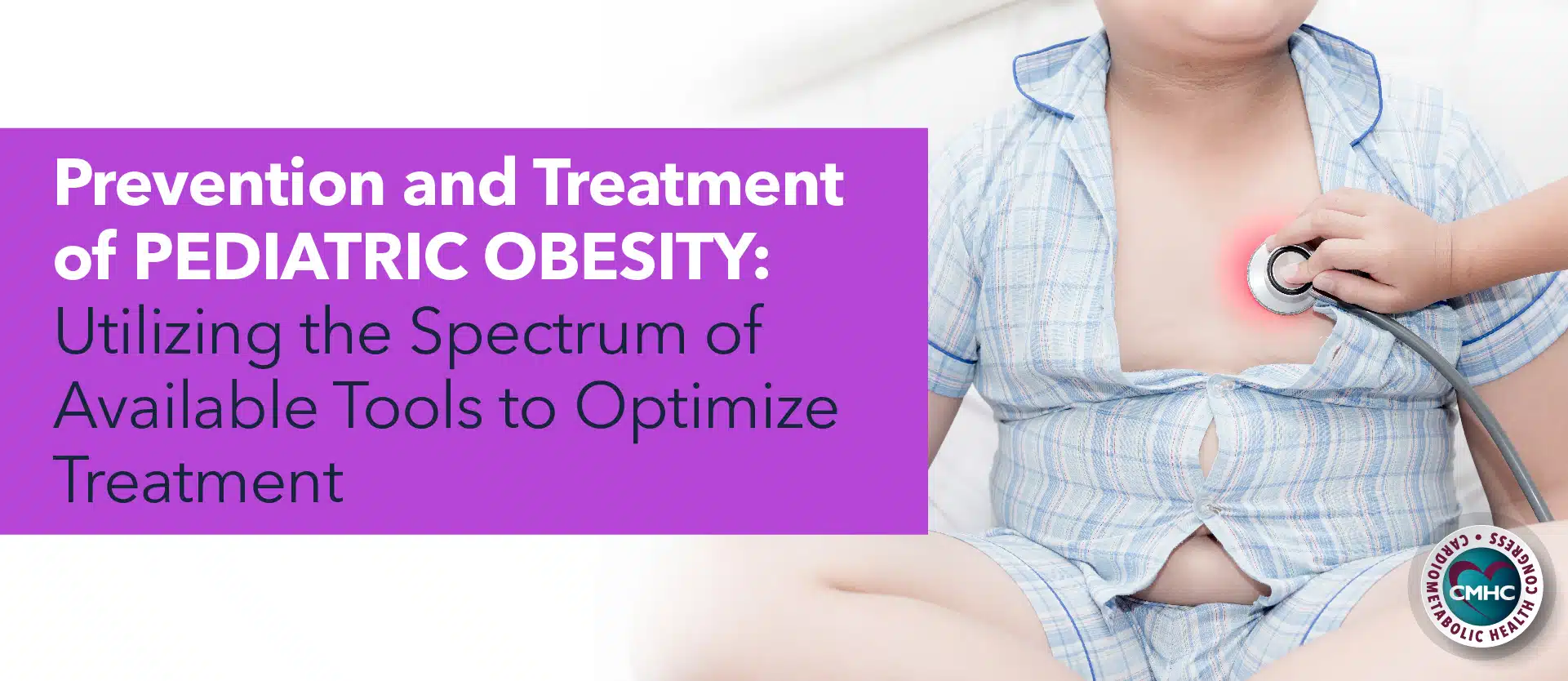The roots of cardiometabolic disease begin in childhood, but many clinicians do not feel confident about screening, diagnosing, and treating these conditions early on. This stems from a host of multifactorial issues, including a lack of solid evidence-base for this population compared to adults, limited treatment options, and lack of familiarity with current guidelines, recommendations, and evidence. As such, addressing the full spectrum of cardiometabolic disease and risk in this population is of paramount importance. This special symposium will contain several sessions on the prevention and treatment of pediatric obesity, including in screening, diagnosis, role of obesogenic environments in obesity development, as well as the medical management of obesity.
Obesity and MetS: Gaps in screening and prevention
The prevalence of metabolic syndrome (MetS), a constellation of risk factors encompassing obesity, hypertension, dyslipidemia, and insulin resistance, is increasing at an alarming rate not only in the adult population, but also in children and adolescents. According to the U.S. Centers for Disease Control and Prevention (CDC), close to 14 million children and adolescents have obesity, with the prevalence increasing by more than 33% in the last two decades. Childhood overweight and obesity is now a worldwide epidemic, is occurring at younger ages, and it is well-known that it can precede the development of cardiometabolic diseases such as atherosclerosis, cardiovascular disease and diabetes. Obesity is strongly correlated with high carotid intima media thickness, a measure of atherosclerosis in younger populations, and other risk factors are now present in children and adolescents with obesity; in fact, more than 60% of these patients have hypertension or dyslipidemia.
The roots of cardiometabolic disease begin in childhood, with obesity being a major underlying factor, thus underscoring the need to screen and address obesity and MetS in this population. However, the challenges of addressing obesity in this population are becoming as immense as in the adult population. Healthy lifestyle choices, such as getting adequate physical activity and a good nutrition, are paramount to preventing and treating obesity and MetS, but are increasingly being subdued by increased screen time and other sedentary behaviors and unhealthy eating. Often, it is difficult to motivate pediatric patients to break out of unhealthy habits, especially when those habits are favored by their home environments. Additionally, due to COVID-19, children and adolescents are increasingly spending more time at home, potentially exposed to more of the behaviors that perpetuate obesity and MetS.
Despite the growing burden of obesity and MetS in the pediatric population, diagnostic and intervention rates are low. Even though clinicians are generally aware of the need to address obesity, overweight, and MetS in their patients, sometimes they fail to address other factors beyond simply asking about diet and physical activity, including beverage intake, family behaviors, screen time, or number of meals and snacks in a day.15 As such, additional education on lifestyle modifications as a cornerstone of obesity and MetS prevention and treatment in the pediatric population is needed.

Challenges in Treating Obesity in Children
Because obesity is central to MetS, lifestyle modifications to decrease body weight are usually the first-line approach, since they have the potential to also address hypertension, dyslipidemia, and insulin resistance.2 If lifestyle modifications alone do not address obesity, or if they do not improve blood pressure or cholesterol levels, then pharmacological and medical treatment may be initiated.4,16 However, often it is not clear what constitutes appropriate medical therapy for the management of pediatric obesity and significant gaps remain in its utilization.
Drug options
Pharmacotherapy for pediatric obesity is relatively understudied; until recently, just one medication – orlistat – was approved by the U.S. Food and Drug Administration (FDA) to treat obesity in adolescents 12 years old or younger. Because orlistat only leads to modest weight loss and no improvement in cardiometabolic factors, other treatments that have been FDA approved for adult obesity are being evaluated in pediatric trials. A new option, liraglutide 3.0mg, was FDA approved in 2020 for the treatment of obesity in adolescents 12 to 17 years of age with a body weight of >60kg and an initial body mass index (BMI) corresponding to ≥30 kg/m2 or greater as adjunct to diet and exercise. The approval was based on a recent study, during which liraglutide 3.0 mg was shown to result in significant weight loss in adolescents (12 to 17 years old) with obesity when added to lifestyle therapy compared to placebo and lifestyle therapy.
Additionally, trials with other drugs are ongoing and results are expected soon. This includes a trial with phentermine/topiramate in pediatric obesity (ClinicalTrials.gov, NCT03922945), which was completed in 2021, and an ongoing trial with semaglutide 2.4mmg, an agent that was approved for adult obesity in 2021, which was completed in early 2022 (ClinicalTrials.gov, NCT04102189).18,19 The full results of these trials will inform the potential role of these agents in the treatment of pediatric obesity.
However, the utilization of obesity pharmacotherapy is not standardized among practitioners, and the utility of this approach in addition to diet and lifestyle should not be ignored.20 Metabolic surgery, an approach that has shown clinically meaningful and durable weight loss, including in the pediatric population, remains vastly underutilized across the age spectrum.
Educational Needs
Given the rapid rise of childhood obesity, it is important that clinicians have expert perspectives about the screening, diagnosis, and treatment to minimize the risk of obesity-related complications later in life. In collaboration with the experts from the Florida Chapter of the American Academy of Pediatrics (FCAAP), Cardiometabolic Health Congress (CMHC) has identified the gaps in clinical knowledge and designed a masterclass to meet the educational needs of pediatric providers.
|
Clinical Gap |
Educational Need |
Learning Objective |
| Despite the growing burden of obesity and MetS in the pediatric population, diagnostic and intervention rates remain low | Clinicians need to be aware of the comprehensive need to screen and address obesity and other cardiometabolic risk factors in children and adolescents | Utilize screening and diagnostic tools to effectively identify and diagnose obesity in the pediatric population
Initiate adequate and personalized lifestyle modifications in consultation with patients and their families to effectively address obesity and MetS in children and adolescents |
| The treatment of pediatric obesity is challenging because of a lack of familiarity with guidelines, lack of evidence, and limited treatment options | Clinicians need to be aware of comprehensive treatment approaches, including pharmacotherapy when appropriate, for the treatment of obesity in the pediatric population | Interpret the efficacy and safety of treatment options for the management of complex pediatric patients with obesity |
References:
- Messiah, Sarah E., et al. “Prevalence of the metabolic syndrome in US youth.” Global Perspectives on Childhood Obesity. Academic Press, 2019. 49-58.
- DeBoer, Mark D. “Assessing and managing the metabolic syndrome in children and adolescents.” Nutrients 11.8 (2019): 1788.
- Hales, Craig M., et al. “Prevalence of obesity among adults and youth: United States, 2015–2016.” (2017).
- Turer, Christy B., Tammy M. Brady, and Sarah D. De Ferranti. “Obesity, hypertension, and dyslipidemia in childhood are key modifiable antecedents of adult cardiovascular disease: A call to action.” (2018): 1256-1259.
- Koskinen, Juha, et al. “Impact of lipid measurements in youth in addition to conventional clinic-based risk factors on predicting preclinical atherosclerosis in adulthood: International Childhood Cardiovascular Cohort Consortium.” Circulation 137.12 (2018): 1246-1255.
- Franks, Paul W., et al. “Childhood obesity, other cardiovascular risk factors, and premature death.” New England Journal of Medicine 362.6 (2010): 485-493.
- Flynn, J. T., D. C. Kaelber, and C. M. Baker-Smith. “Subcommittee on Screening and Management of High Blood Pressure in Children. Clinical Practice Guideline for Screening and Management of High Blood Pressure in Children and Adolescents (vol 140, e20171904, 2017).” Pediatrics 142.3 (2018).
- Expert Panel on Integrated Guidelines for Cardiovascular Health and Risk Reduction in Children and Adolescents. “Expert panel on integrated guidelines for cardiovascular health and risk reduction in children and adolescents: summary report.” Pediatrics 128.Suppl 5 (2011): S213.
- Elkins, Casey, et al. “Clinical Practice Recommendations for Pediatric Dyslipidemia.” Journal of Pediatric Health Care 33.4 (2019): 494-504.
- Savage, Jennifer S., Jennifer Orlet Fisher, and Leann L. Birch. “Parental influence on eating behavior: conception to adolescence.” The Journal of law, medicine & ethics 35.1 (2007): 22-34.
- Rundle, Andrew G., et al. “COVID‐19 Related School Closings and Risk of Weight Gain Among Children.” Obesity (2020).
- Dorsey, Karen B., et al. “Diagnosis, evaluation, and treatment of childhood obesity in pediatric practice.” Archives of pediatrics & adolescent medicine 159.7 (2005): 632-638.
- Wethington, Holly R., Bettylou Sherry, and Barbara Polhamus. “Physician practices related to use of BMI-for-age and counseling for childhood obesity prevention: a cross-sectional study.” BMC family practice 12.1 (2011): 80.
- Tanda, Rika, and Pamela Salsberry. “The impact of the 2007 expert committee recommendations on childhood obesity preventive care in primary care settings in the United States.” Journal of Pediatric Health Care 28.3 (2014): 241-250.
- Nelson, Jennifer M., et al. “Weight management-related assessment and counseling by primary care providers in an area of high childhood obesity prevalence: current practices and areas of opportunity.” Childhood obesity 11.2 (2015): 194-201.
- de Ferranti, Sarah D., et al. “Cardiovascular risk reduction in high-risk pediatric patients: a scientific statement from the American Heart Association.” Circulation 139.13 (2019): e603-e634.
- Kelly, Aaron S., et al. “A randomized, controlled trial of liraglutide for adolescents with obesity.” New England Journal of Medicine (2020).
- ClinicalTrials.gov, NCT03922945. “A phase IV safety and efficacy study of VI-0521 in obese adolescents.” Available at https://clinicaltrials.gov/ct2/show/NCT03922945, accessed March 7, 2022.
- ClinicalTrials.gov, NCT04102189. “A research study on how well semaglutide works in adolescents with oberweight or obesity.” Available at https://clinicaltrials.gov/ct2/show/NCT04102189, accessed March 7, 2022.
- Srivastava, Gitanjali, et al. “Clinical considerations regarding the use of obesity pharmacotherapy in adolescents with obesity.” Obesity 27.2 (2019): 190-204.


















